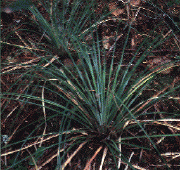

Common Names: Indian
Basket Grass, Soap Grass, Squaw Grass
Genus: Xerophyllum
Species: tenax
Parts Used: roots and leaves are used in weaving

Bear Grass looks like a grass, but really belongs to the lily family. It is about 4.5 feet tall. Its olive-colored, grass-like leaves grow from the base of the plant and are tough and wiry. The outside leaves clasp around the stem. The leaves have toothed margins, and grow about 35 inches long, getting shorter as they near the flowers, looking very much like a fan.
The flowers of bear grass grow on a stalk that can be 6 feet tall with many small flowers. Each flower is creamy white, and saucer shaped, and has a sweet aroma.
The lowest flowers bloom first, creating a tight knot of buds at the top. The entire flower looks a little like fluffy, upside down ice cream cone. Bear grass tends to flower in 5 to 7 year cycles. After the fruit sets, the plant dies. It reproduces by seed, and by sending out offshoots from its rhizomes.
Bear grass is found in open forests and meadows at sub alpine and low alpine elevations in the western United States. It is commonly found under alpine larch (Larix lyallii) and whitebark pine (Pinus albicaulis) stands on cold, rocky sites at upper timberlines.
Bear grass is a fire-resistant species that is the first plant to grow after a fire. Beargrass, and many other native plants, need periodic burns to produce strong, new growth. After a fire beargrass sprouts from its rhizomes which lie just under the surface. Light fires of short duration are best. Intense fires which linger in the same place for a long time will kill the rhizomes under the ground, and prevent the beargrass from growing back.
Native Americans in Oregon, Washington state, and British Columbia have traditionally made beautiful baskets with the stems and roots of beargrass. When the leaves are dried in the sun in preparation for making baskets, they turn a creamy white. Combined with other materials of different colors, beautiful designs were woven into the baskets. Hats and other practical objects were also made of beargrass. A wonderful site to find out more about Native American basket weaving is: http://www.kstrom.net/isk/art/basket/baskmenu.html
2002
Bibliography:
"Bear Grass", http://www.timbermountain.com/wildflowers.html, (6-23-00)
"Botanical and Ecological Characteristics", http://www.fs.fed.us/database/feis/plants/forb/xerten/botanical_and_ ecological_characteristics.html
"Basketry, Hats, Footgear--Native American Art", http://www.kstrom.net/isk/art/basket/bascloth.html, (8-19-02).